| |
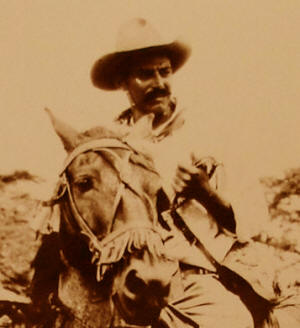
|
 |
 |
 |
 |
| |
TO 31 MARCH
1929 |
1-24
APRIL 1929 |
25
APR-JULY 1929 |
PHOTOS |
This is the
THIRD of FOUR MAIN pages
housing materials relating
to the
fascinating case of the Voluntarios,
a counterinsurgency experiment
that the US Marines undertook from January to
June 1929 to augment the native
Guardia's limited military capabilities in the
fight against Sandino & the EDSN.
Photo: Liberal & Voluntario General Juan
Escamilla in Jinotega, 1929.
This
final page of documents on the Voluntarios
continues with the patrol & combat
reports of Lt. Hanneken & General Escamilla,
followed by memoranda, letters & reports of other
leading officials and newspaper accounts that contribute additional
revealing details. The collection
concludes in late July, about a month after the
disbandment of the last of the Voluntario
forces, with several reports on the "local
native situation" on the outskirts of Yalí, where hundreds of
campesino men, women & children had sought
refuge from the relentless violence &
intimidation of Hanneken, Escamilla, Lee, and
other key actors in the
counterinsurgency campaign in the hills &
valleys of rural Jinotega. One such
report, from the Managua newspaper El
Comercio, ironically and inaccurately
blamed the Sandinistas, especially General Pedro
Altamirano (or Pedrón) for the "pitiful scenes
of misery & hunger" across Jinotega, and
especially among "los reconcentrados" in Yalí.
All the other documents in this collection make
abundantly clear that these "pitiful scenes"
were the result of the terror & violence
inflicted on the rural populace by Hanneken,
Lee, Escamilla, and other US Marines &
Nicaraguan Voluntarios.
Tacked on
at the end are two documents from
November 1931 that show an effort to revive the
Voluntario program, and its complete rejection
by the Marine-Guardia brass. By this time,
the counterinsurgency forces had learned their
lesson. Grateful acknowledgement is
extended to volunteer transcriptionist Mr.
Brandon Ray, Summa Cum Laude college
graduate from Ashford University in Iowa (with a
B.A. in History and a minor in Political
Science) for his exacting transcriptions of
these final two documents.
|
|
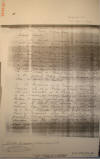
|
April 26, 1929.
"Report," Lt. Hanneken, Guapinol, p. 1.
"1.
Lt. Hanneken, 10 marines, General Escamilla,
and 30 Volunteers cleared La Pavona at 0630
for Guapinol, on 25 April. ¶ 2.
Lt. Jordan Paige, 18 Marines, 1 Navy
enlisted, and Colonel Pancho Estrada with
remaining Volunteers and all pack animals
cleared La Pavona at 0800 for Guapinol on 25
April. ¶ 3. Lt. Hanneken patrol
arrived at Guapinol at 1400, 25 April. Plane
made message drop at about 1430 re – Relief
Marine Patrol at Yali. ¶ 4. Lt.
Jordan’s Patrol arrived at Guapinol at 1800,
25 April – No Contact. ¶ 5. At
Guapinol is the Finca of one MATEAS VASQUEZ,
who is a brother of JESUS VASQUEZ, who was
executed at La Pavona, and Mateas is the
cousin of SANTOS VASQUEZ, Bandit jefe.
Mateas Vasquez reported on his own account
to me at about 1600, stating he had just
returned from SAN ANTONIO. Vasquez led
patrol to a large champas about one half a
mile NORTH of Guapinol, where his family is
at present living and hiding. Present at
this champas were his wife, 2 young sons,
and three grown up daughters with 6 small
children. . . ."
|
|
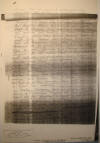
|
April 26, 1929.
"Report," Lt. Hanneken, Guapinol, p. 2.
"
. . . Vasquez had an excellent
recommendation from the Jefe Politico of
Jinotega dated August 1928 and also a
notation thereon by Captain Shaw, U.S.M.C.
to the effect that he, Vasquez, had acted on
several occasions as guides for Marines in
area of Guapinol. Vasquez stated that SANTOS
VASQUEZ before he went with Pedron had
always lived with him at Guapinol and that
Pedron forced SANTOS to go with him. That
the last time he saw Santos and Pedron was
last August. On the other hand I have
definite and reliable information that
Pedron with Santos and band had camped at
Guapinol at the house of Vasquez for 24
hours on or about March 10, and that Pedron
often passes at Guapinol. It is my belief
that Mateas Vasquez has protection from both
sides. His finca has 3 houses and about 30
beef and his family does not appear to have
been molested. ¶ 6. Mateas
Vasquez and his family and the family of
FILADELPHIA RIVERA are leaving on April 27
for Jinotega to report to Jefe Poltico.
¶ 7. Entire patrol will clear Guapinol
on April 27 for LOS CEDROS, will camp there
over night and on the 28th. ¶ 8,
This patrol has rations to May 1st.
Volunteers have rations to about May 10.
¶ H. Hanneken ¶ Copy to
Area Comdr. Southern Area."
|
|
_small.jpg)
|
April 26, 1929
"18 Capturados,"
La Tribuna (Managua).
"De Jinotega, el Jefe
Político coronel Pedro López, trascribe al
Ministro de Gobernación un telegrama del
jefe Expedicionario [Escamilla],
en el que da cuenta que después de haber
recordrido todas las montañas de Yalí, se
encuentra sin novedad y con 18 rebeldes
capturados."
|
|
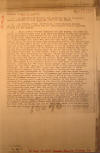
|
April 28, 1929.
"Report of Contact," Lt. Hanneken, Los
Cedros (typed copy), p. 1. [NOTE:
This is a 2-page typed copy of the 5-page
handwritten original that appears
immediately below] "1. Lt.
Hanneken 10 Marines,
Gen. Escamilla and 30
Volunteers cleared GUAPINOL at 0630 April
27, 1929 for LOS CEDROS. ¶ 2.
Lt. Jordan Paige, 18 Marines, 1 Navy Colonel
Estrada and all remaining Volunteers and all
pack animals cleared GUAPINOL at 0730 for
LOS CEDROS. ¶ 3. About midway
between GUAPINOL and LOS CEDROS, the
combined forces of bandits under Jose Leon
Diaz and Pedron Altimirano apparently had
arranged a neat ambush for us, but due to
the alertness of our point their
expectations were not realized. The ambush
was laid in a ravine where the trail was
entirely open and a large force therein
could be plainly seen from surrounding
hills. The bandits had it covered from three
hills, 2 to the front and one to the rear,
but when our point with Capt. Miguel Sanchez
of the Volunteers in charge arrived on the
threshold of the ravine he espied several
men with red and blue hat-bands [p. 2
handwritten original] moving
about in one of the hills to the front and
passed word back to that effect. When I
received the word, the bandits who were
occupying the ground, (which was meant to be
in our rear for the ambush, but which now
was on our immediate right) opened up fire,
with one machine gun and rifles. Three bombs
were thrown from same locality in a period
of about 5 seconds. Had marines take cover
and opened up on position where fire came
from. Could see no bandits. Although the two
other bandit groups could not see us they
opened up fire also. During the first burst
of fire Miguel Sanchez, volunteer, was shot
thru left upper arm, near shoulder, a flesh
wound and not serious. After one minute of
firing had men cease firing and sent
detachment of Volunteers into position where
bandits had fired from. Organized other
volunteers and placed 3 Brownings and
riflemen in position covering the other 2
hills to our front and advance by firing
upon 2 positions of bandits to the front.
Bandits returned fire spasmodically and by
the time the Volunteers reached the 2 hills
all firing ceased. Reorganized patrol and
reconnoitered ground and found that bandits
had two known [p. 3 handwritten
original] wounded, one of whom had
apparently been shot thru the mouth or jaw
as we found some teeth and a trail of blood,
and the other wounded was apparently
bleeding freely, these being two separate
trails of blood. Bandits took off in all
directions, leaving some of their small bags
with some rations, going in the directions
to the west toward the PANTASMA VALLEY or
toward BILAN. About 5 minutes after contact,
planes passed about a mile away toward
GUAPINOL and from later information worked
Lt. Jordan’s patrol. Burned smoke bomb to
attract attention of planes but they left.
Lt. Jordan who was at that time about 3
miles away did not hear any firing. During
period while my patrol was reconnoitering .
. . "
|
|
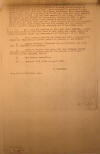
|
April 28, 1929.
"Report of Contact," Lt. Hanneken, Los
Cedros (typed copy), p. 2.
" . . . Lt.
Jordan's patrol arrived. Jordan
received message by drop that Yali Marines
would be in Guale on April 28. Entire
command proceeded to LOS CEDROS where we
arrived at about 1400. Patrols were sent out
and rounded up everybody in area, which
brought us about 30 women and several men.
[p. 4 handwritten original]
From information gathered it was
learned that Jose Leon Diaz and Pedron
Altamirano have consolidated their bands,
giving them about 50 or 60 men. They have
been together for at least 5 days, and had
been camped at the finca of Inez Rodriguez
at LOS CEDROS for three days, leaving at
0500 on April 27. Mrs. Rodriguez states that
Pedron’s men did not have much ammunition
but that Diaz men did. That everyone around
area prepared food for them. That Pedron was
out for revenge for the execution of the
spies we caught and the clearing out of LA
PAVONA Area. ¶ 4. Will send all
natives in this area into JINOTEGA. Pedron
has been known to come thru here very often
and always camped at Inez Rodriguez finca.
The whereabouts of Rodriguez is not known.
¶ 5. Have several patrols out today
and sent a messenger to GUALE for YALI
Marines Relief patrol to proceed to LOS
CEDROS. ¶ 6. Miguel Sanchez,
Volunteer who was wounded, has been sent to
JINOTEGA this morning. ¶ 7.
Believe bandits have gone into the PANTSAMA
VALLEY and upon reporting of relief patrol,
the present patrol will proceed up the
PANTSAMA VALLEY. ¶ 8. No Marine
casualties. ¶ 9. Contact took
place at about 0900. ¶ H.
HANNEKEN ¶ Copy for C.O.
Northern Area."
|
|
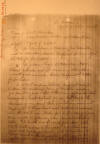
|
April 28, 1929.
"Report of Contact," Lt. Hanneken, Los
Cedros (handwritten original), p. 1. [Transcribed
immediately above]
|
|
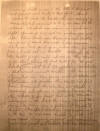
|
April 28, 1929.
"Report of Contact," Lt. Hanneken, Los
Cedros (handwritten original), p. 2. [Transcribed
immediately above]
|
|
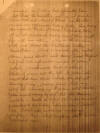
|
April 28, 1929.
"Report of Contact," Lt. Hanneken, Los
Cedros (handwritten original), p. 3.
[Transcribed
immediately above]
|
|
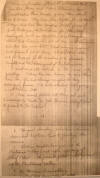
|
April 28, 1929.
"Report of Contact," Lt. Hanneken, Los
Cedros (handwritten original), p. 4.
[Transcribed
immediately above]
|
|
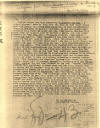
|
April 29, 1929.
Telegrama de G.
Morales C., Jefe de Policía, Jinotega, al Ministerio de Gobernación,
Managua. "Let
me inform you that yesterday Mr. Mamerto
Martinez, a priest student, came to this
city and told us that while being with his
family in a farm near Santa Fe, of this
jurisdiction, where he had gone to spend a
vacation, he and his family were captured by
a force of about 250 men, well armed, who
had with them four (4) machine guns of
different makes, and were under command of
Jose Leon Diaz, Francisco Estrada, Pedro
Irias, Sebastian Conteno, Pedro Altamirano
and some other jefes who names he was not
able to learn. After the semmarist
[seminarian] and his family had been
captured their house (the one at their
finca) was robbed and they were led into the
heart of a mountain where the night was
spent. This occurred last Tuesday and, he
adds, on behalf of his supplications, his
father and brothers did not get killed, and
all were released Wednesday morning, that
is, the following day. That he was told they
would not cease fighting as long as there
are Yankees in Nicaragua and Moncada is in
office, and that they were expecting an
armament that was to come from Mexico in
order to take up a strong offensive
attacking cities. Hours after Semmarist
Martinez had informed the above, an express
postman came, sent by
General Escamilla,
bringing with him
Captain Miguel Sanchez who
had been wounded in the arm. General
Escamilla informs that yesterday, between
nine and ten a.m., coming from La Pavona and
El Guapinol with an idea of reconnoitering
all these mountains in search of bandits, he
was attacked by a group of them at the place
called El. Ventarron, near Los Cedros, about
nine leagues from this city. The attacking
group of bandits was composed of about 80
men, well armed and under command of Pedron
himself and Jose Leon Diaz. That he repelled
the attack, which lasted for about half an
hour, dispersing the bandits, who according
to traces they left in the woods they were
fleeing through, were carrying many wounded,
and also left over twenty-give packages with
clothes and provisions, which were taken by
his (Escamilla’s) soldiers. He is chasing
them closely. That in the said place of Los
Cedros where they keep their largest camps
according to reports he has received, said
camps will be searched until he destroys
them. As soon as I have some more
information I’ll communicate same to you. ¶
(s) G. Morales C. ¶ Director of Police."
|
|
_small.jpg)
|
April 30, 1929.
"Encuentros
militares," La Tribuna (Managua).
"Las fuerzas que
comanda el
general Escamilla, en el
punto denominado La Pavona tuvieron un
encuentro con un grupo de rebeldes bien
armados y como en número de 80. ¶
Dice Escamillas, que en ese encuentro los
alzados dejaron en su poder treinta bultos
de mercanderías, fruto de sus correrías. Un
seminarista secuestrado y que fue puesto en
libertad, asegura ser como 200 hombres los
que operan al mando de Pedrón, José León
Díaz y otros, ya juntos."
|
|
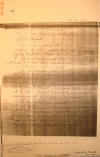
|
April 30, 1929.
"Report," Lt. H. H. Hanneken, Los Cedros, to
Northern Area Commander, p. 1.
"1. Various patrols
out in the Los Cedros area on April 28
reported back with no news of any bandits.
Planes were not sighted. ¶ 2.
Aeroplanes passed thru Pantasma Valley April
29th and I burned three smoke bombs to
attract their attention without result.
¶ 3. Lt. Hanneken, Jordan and Paige
and 28 Marines, one Navy enlisted cleared
Los Cedros at 1400 April 29 and arrived at
Guale at about 1830. Lt. Troxell and Yali
Marines had arrived at Guale at about 1530
same date. Camped at Guale.
General
Escamilla and Volunteers remained at Los
Cedros. No contact. ¶ 4. My
patrol was relieved by Lt. Troxell and Yali
Marines at 0700 April 30. Lt. Troxell and 30
Marines cleared Guale at about 0730 for Los
Cedros. Lt. Troxell is going to Corinto
Finca on May 1st to obtain rations as he had
only 4 days rations when he left Yali. . . .
"
|
|
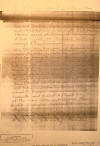
|
April 30, 1929.
"Report," Lt. H. H. Hanneken, Los Cedros, to
Northern Area Commander, p. 2. "
. . . Cleared Guale at 0730 for Las Piedras
on the Coco and Quilali. Arrived at Las
Piedras at 1330 and established camp for the
night. Lieut. Hanneken 6 marines cleared Las
Piedras at 1330 and arrived at Santa Cruz at
1400. No contact. Sent several messages to
Area Commander. ¶ 6. Had Inez Rodriguez, who
happened to be across Rio Coco near Santa
Cruz, arrested. I have been trying to locate
this man for the past month. He is Pedron’s
Quartermaster and spy jefe in Los Cedros
Area. Pedron has camped on his finca about 6
dozen times in the last year and Rodriguez
was in the camp the majority of times. This
being proven by Manuel Matute, who had
camped at Los Cedros with Pedron and also by
various other people around Los Cedros. Have
requested that Escamilla send patrol to
Santa Cruiz to get this man. When confronted
with Manual Matute, Rodriguez confessed to
above allegations. ¶
7. Manuel Matute, ex bandit, will remain at
Santa Cruz and work for Guardia."
|
|
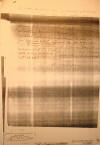
|
April 30, 1929.
"Report," Lt. H. H. Hanneken, Los Cedros, to
Northern Area Commander, p. 3.
" . . . He knows the
entire area in vicinity of Santa Cruz and
also all natives residing therein and will
be of valuable assistance in locating
bandits (individually). He has rendered
valuable assistance to us so far. Manuel
Matute returned to
Gen. Escamilla’s column
on May 1st. ¶ 8. Cleared Santa
Cruz at 0730 on May 1st and arrived at Las
Piedras at 0800 and proceeded with entire
patrol to Quilali where we arrived at 1330.
No contact. ¶ Lt. Hanneken"
|
|
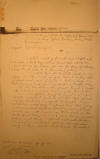
|
May 2, 1929.
"Operations Report," 2nd Lt. Walter H.
Troxell, Jinotega, to Northern Area
Commander, Ocotal, p. 1.
"1. A patrol
consisting of Lieutenant Troxell and 30
enlisted with 4 days rations cleared Yali at
0630, April 28, 1929, for Guali, for the
purpose of relieving First Lieutenant H. H.
Hanneken’s patrol. ¶ 2. The
patrol took the trail to Santa Fe, via
Coyolar. I made camp at 1630 at La Paz which
is almost 3 miles east of Santa Fe. Natives
along the trail were questioned concerning
bandit activities. They stated that they had
neither seen nor heard of bandits. ¶
3. The patrol cleared La Paz at 0630, April
29, 1929. Arrived at Santa Fe at 0800. There
the natives were questioned also in regards
to bandits. They reported that a small group
had passed thru there, going north, on or
about April 16, 1929. They did not know who
the jefe of the bandits was. We arrived in
the Santa Maria Valley about 1230. Saw two
small planes flying about Guali. Could not
work with the planes. Arrived at Guali at
1600 April 29, 1929 and made a camp.
Distance covered about 20 miles. No contact.
. . . "
|
|
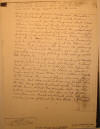
|
May 2, 1929.
"Operations Report," 2nd Lt. Walter H.
Troxell, Jinotega, to Northern Area
Commander, Ocotal, p. 2.
" . . . ¶ 4.
Lieutenant Hanneken with his Patrol (Marines
only) arrived at Guali about 1800 and also
made camp. Reported to Lt. Hanneken as
relief for his patrol. Lieutenant Hanneken
told me that he had contact with Pedron
Altamirano and Jose Leon Diaz and about 50
men between Los Cedros and Guapinol at 1000
April 27, 1929 and that he (Lieutenant
Hanneken) would make an official report of
it. That the above Jefes probably moved into
the Pantasma Valley or back into the La
Pavona Area. That
General Escamilla and his
vigilantes are camped at Los Cedros, and for
me to go and join the General the following
morning. Lieutenant Hanneken gave me the
information concerning patrolling and
working with the Vigilantes. ¶ 5. At 0700
April 30, 1929 Lieutenant Hanneken and his
patrol cleared Guali for Quilali. I cleared
Guali at 0700, April 30, 1929 for Los Cedros
to join General Escamilla. Los Cedros is
about 4 miles east of Guali. When I was
within 500 yards of Los Cedros, two small
planes were seen flying over us. But they
could not see my panels, due to the heavy
thick brush and woods I was in at the time.
About ten minutes later as the patrol came
out into the open on top of the mountain, we
heard short bursts from the planes machine
guns, followed by two bombs. I proceeded . .
. "
|
|
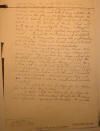
|
May 2, 1929.
"Operations Report," 2nd Lt. Walter H.
Troxell, Jinotega, to Northern Area
Commander, Ocotal, p. 3. "
. . . into Los Cedros, and arrived there in
time to see the planes leave the area flying
south. I met General Escamilla, and asked
him whether he saw where the planes dropped
the bombs. He said he didn’t, but pointed
and said they had been in the direction of
Guali. I did not go to Guali to investigate
because I thought that if the planes had
sighted bandits they would have returned to
Los Cedros and dropped a message to
Escamilla giving the information and
location. I did not know where it had been
that the bombs were dropped either. ¶ 6. I
am basing at present at Los Cedros. When I
arrived there, I still had two days rations
for 30 men left. Figuring that two days
rations for 30 enlisted would be sufficient
for 15 enlisted for four days, I cleared Los
Cedros at 0700, May 1, 1929 with 15
enlisted, 40 vigilantes, and 12 pack mules
for Jinotega to draw 10 days rations. I left
15 enlisted in Los Cedros with General
Escamilla and rest of vigilantes. I arrived
in Jinotega at 1630, May 1, 1929. Distance
covered about 24 miles. No contact. ¶
7. Expect to clear Jinotega for Los Cedros
not later than May 3, 1929. ¶ 8.
Before I left Los Cedros for Jinotega,
General Escamilla told me that he expected
to receive some information regarding the
bandits. He said he . . . "
|
|
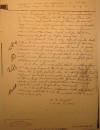
|
May 2, 1929.
"Operations Report," 2nd Lt. Walter H.
Troxell, Jinotega, to Northern Area
Commander, Ocotal, p. 4.
" . . . expected to
receive the information in the next two or
three days. That he had a messenger up or
around Guapinol. If he hasn’t any
information by the time I return, I will
keep my base at Los Cedros and work around
there for several days. Or unless I get
information concerning bandits that will
force me to leave Los Cedros and move and
make another base, I will notify the Area
Commander by pick up, before doing so.
¶ 9. At present I have only 9 pack
mules. Should I have to move, at once, the
whole outfit of Marines, it would be
impossible for me to move 31 packs (blanket
rolls) and 10 days rations with only 9 pack
animals. Therefore, I request that I be
furnish with 10 more pack animals with
complete pack saddles as soon as possible.
¶ 10. It is also requested that
another officer or a Gunnery Sergeant be
furnished. Because then the whole patrol can
be split into two different patrols and work
separate for two or three days. As it is
now, the patrols cannot be split, unless I
send a patrol (that is Marines and
vigilantes) with a Sergeant in Command.
¶ 11. I do not have a corpsman with
the patrol. It is requested that I be
furnished with one as soon as possible.
¶ W. H. Troxell ¶ 2nd Lt.
U.S.M.C."
|
|
_small.jpg)
|
May 3, 1929.
"Abusos de las
tropas en el Norte," La Tribuna,
reprinted from La Noticia (Managua).
"‘La
Noticia’ acaba de publicar el dato de que en
la zona del Norte se están cometiendo
irregularidades de gran trascendencia por
las tropas del General Escamilla, como la de
fusilar a varios hombres que posiblemente no
estaban compremetidos en los trastornos del
orden público en aquella región. ¶
Nosotros tenemos conocimiento de que además
de los injustos fusilamientos que se han
efectuado tras un consejo de guerra formado
por hombres analfabetas, completamente
irresponsables, las tropas del General
Escamilla cometen actos de verdadero
salvajismo en gentes indefensas. ¶
Las familias de aquellas regiones se ven
acosadas por uno y otro lado; no son pocas
las doncellas que han sido víctiimas de las
bestialidades de las tropas del Gobierno
siendo después despachadas a Jinotega en
calidad de prisoneras. ¶ Por
otra parte se nos informa que las tropas del
General Escamilla no han sostenido ningún
encuentro con gentes de las que andan por
aquellas montañosas regiones del país, pues
si es verdad que han buscado a los hombres
armados de Pedrón y demás descontentos,
nunca han tenido la oportunidad de
encontrarse con ellos. ¶ Nuestro
informante ingora sí, todo lo que se refiere
al último encuentro de que se habló en los
diarios de esta capital, que se dice tuvo
efecto entre El Cedro [Los Cedros] y
Guapinol, que bien puede ser cierto, como
también puede ser falso, igual que los
informes anteriores. ¶ Este
grave asunto reclama una urgente
investigación del Gobierno, pues no es
posible que esos hechos bestiales
perpetrados en pobres e indefensos
nicaragüenses queden cubiertos por el velo
de la impunidad. ¶ Precisamente,
el error y la responsibilidad del Gobierno y
del interventor están en haber puesto al
trente de las tropas nicaragüenses a
aventuros extraños, sanguinarios e
irresponsables."
Notes & Comments:
One of the frustrations about Nicaraguan
journalism during this period is the lack of
specificity: names, places, dates,
events, individual stories, none appear
here. Instead we see generic
descriptions of "salvajismo" in the "zona
del Norte" against the "gentes pobres e
indefensas". Despite this lack of
specificity, the allegations are entirely
consistent with everything else presented
here and suggest the extent to which
narratives about the violence of Hanneken &
Escamilla were circulating in the
country's major cities at the time.
|
|
_small.jpg)
|
May 14, 1929.
"Notas — El 2º de
Escamilla," La Tribuna (Managua).
" . .
. Miguel
A. Esquerro ha sido nombrado
2º del jefe expedicionario Escamilla para
acompañarlo en el norte."
|
|

|
May 18, 1929.
"Memo for R-3, 11th Regt" [Captain Buse,
Ocotal], Major Hans Schmidt, Managua.
" . .
. MEMO FOR R-3, 11TH REGT: ¶ The
JINOTEGA AREA did not keep me very well
informed on the Volunteer situation, with
what results you already know. ¶
Now that Esquerro is in SOMOTO and probably
gathering some men and in view of the fact
that Hanneken does not want any more, I am
in doubt as to what to do. Anything you do
will be O.K. Either let him take what few
men he has and go to JINOTEGA to eventually
replace some of
Escamilla’s men or disband
them and send Esquerro back here. ¶
I had been told that only 30 men would go
with Escamilla and therefore the mixup. It
appears now that he cleared with 50. ¶
The President of course thinks that he
should have more but I have pointed out that
those things should be left to Colonel
Dunlap for his decision. ¶ If
you can use the Esquerro men for a short
while do so, if not let them go. ¶
H. SCHMIDT, Major, USMC B-2"
|
|

|
May 20, 1929.
"Memo for B-2," Captain K. I. Buse, Ocotal
(Response to Hans Schmidt Memo of 18 May).
"
. . . REFERENCE: Your Memo dated 18 May
1929. ¶ 1. Upon receipt of
Brigade’s dispatch 8618-1253,
Esquerro, who
had arrived in Somoto on the 17th. instant,
was instructed not to commence recruiting
for the Voluntarios and returned to Ocotal
yesterday. ¶ He was sent to
Managua this morning and has probably
reported to you for further transportation
the Hanneken-Escamilla column. ¶
2. Colonel Dunlap is of the opinion that a
group of fifty (50) Voluntarios is
sufficient for
Escamilla. ¶ K.
I. BUSE. ¶ Captain USMC. R-3"
|
|
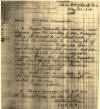
|
May 22, 1929.
"Memo: Brigade Commander," Guardia Nacional
Captain H. Hanneken, 2 miles N.W. of Corinto
Finca (in coffee zone east of Jinotega).
"
. . . 1. General Escamilla has several
recent telegrams from the Secretary of War,
Nicaragua telling the General to go ahead
and recruit the Volunteers to a strength of
100 men. General Escamilla has gone head and
recruited 15 men and has 64 men at present.
He also received a telegram today that
Colonel Esquerro with about forty (40)
recruits from Somoto would arrive in
Jinotega tomorrow May 23 to join him.
¶ 2. While I was in Jinotega I was
told that Escamilla Volunteer strength was
limited to 50 men. ¶ 3. Please
advise. ¶ 4. Radio message will
get me at Corinto Finca on the 23rd. ¶
H. Hanneken Capt., G. N."
|
|
_small.jpg)
|
May 23, 1929.
"Manos Libres a
Escamilla," La Tribuna (Managua).
"Leemos en el
Diario Moderno de fecha de ayer la siguiente
noticia que no puede ser más alarmante:
‘Escamilla con plenas facultades. Se dispuso
ayer por el Ejecutivo que el general
Escamilla tenga en lo sucesivo plenas
facultades para proceder como mejor
convenga para perseguir y destruir las
cuadrillas de bandoleros que infectan
las Segovias’. ¶ Semejante paso
es de suma gravedad, desacreditará al
gobierno actual dentro y fuera de Nicaragua
y llenará de pavorosa alarma a los
desgraciados habitantes de los departamentos
del Norte a quienes se deja a merced de la
ferocidad de un aventurero para cuyas
matanzas al por mayor, desde antes de tener
ilimitadas facultades, pedía un freno de
órgano de reconocida importancia del partido
liberal, La Noticia. ¶
Escamilla, que no es nicaragüense sino un
desalmado guerrillero extranjero, no tiene
arraigo ninguno en Nicaragua, no conoce la
gente de los lugares de donde lo acaban de
nombrar señor de vidas y de haciendas y no
tiene otro interés en nuestras luchas que el
que puede inspirarle su propensión anímica a
la matanza y a todas las atrocidades de la
guerra. ¶ El gobierno de
Nicaragua, a nuestro juicio, hace una ofensa
a los militares nacionales al no escoger de
entre ellos el director de la pacificación
de las Segovias. Militares nicaragüenses
honorables, de la completa confianza del
Ejecutivo, valiente, amantes de su país,
conscientes de que los sublevados son tan
nicaragüenses como los que ocupan las
curules gubernativas, podían ponerse al
frente de las fuerzas pacificadoras y
alcanzar un éxito perfecto, inesperado
quizá. Pero enviar un soldado de aventuras,
que se imagina que con diezmar campesinos y
aterrorizar campesinas concluirá prontamente
con un movimiento crónico que requiere el
estudio de los hombres de pensamientos como
lo requiere un verdadero problema de estado,
nos parece un error de lo más funesto, de lo
más deplorable. ¶ Ojalá que los
hombres de consejo del liberalismo influyen
en el mandatario para que éste se ocupe del
asunto del Norte con la debida medicación, y
que sus resoluciones sean basadas en el
parecer de los ciudadanos importantes de
aquellos departamentos, a quienes sin duda
les atañe de modo más directo este negocio y
que conocen más a fondo que los del interior
las peculiaridades de aquellas regiones, en
todo sentido."
|
|
_small.jpg)
|
May 24, 1929.
"Notas — A Jinotega,"
La Tribuna (Managua).
"Salió en avión para
Jinotega el 2º de Escamilla,
coronel Miguel
Ezquerro, quien capturó a
las 45 mujeres de a famosa cueva y
correspondencia del General Sandino, de la
cual se apoderaron soldados americanos, que
no hand dado cuenta a las autoridades del
país."
|
|

|
May 24, 1929.
Memorandum from the Commanding General, 2nd
Brigade, USMC (Geo. T. Hall, by direction),
to Jefe Director, Guardia Nacional.
" . . . 1. For your
information and return. ¶ Capt.
Hanneken has been informed that
Escamilla
will be authorized to retain the fifteen
recruited, but not allowed to receive or
recruit more. He has been informed that
Esquerro went to Jinotega by plane on 23
May, but does not have Somoto recruits with
him. ¶ GEO. T. HALL, By
direction . . ."
|
|
_small.jpg)
|
June 1, 1929.
"Se fue el Ministro
Caldera," La Tribuna (Managua).
"El
general
Augusto J. Caldera, nombrado
Ministro residente de Nicaragua en Honduras
en sustitución de don Francisco J. Moncada
que regresó hace pocos días de Tegucigalpa,
tomó el tren para Chinandega. Se había dicho
que el general Caldera iría a la citada
república en misión especial, pero a última
hora el Presidente Moncada resolvió
investirlo con el carácter de Ministro
residente. ¶ Acompaña al general
Caldera su hija Ella María. Dentro de pocas
semanas saldrá para Tegucigalpa la esposa
del general."
Notes & Comments:
General Caldera, dismissed from the
Voluntarios, is appointed "Resident Minister
of Nicaragua in Honduras" by President
Moncada -- another plum job.
|
|
_small.jpg)
|
June 13, 1929.
"Notas — 25
Voluntarios," La Tribuna (Managua).
" . . . ¶
25 voluntarios
¶ El
coronel Isaac Solano llegó
ayer a esta capital conduciendo 25
voluntarios para prestar sus servicios en
las tropas al mando del
general
Escamilla. ¶
Vinieron a pedir órdenes; y es posible que
mañana salgan para Jinotega. Son de
Chichigalpa."
|
|
_small.jpg)
|
June 19, 1929.
"Gran gentío en Yalí,"
La Tribuna (Managua).
"Yalí, 17 de Junio de
1929. ¶ Sr. Presidente de la
República: ¶ La gente que ha
salido de la montaña que estaban apoyando al
bandolerismo son como 500 hombres; hoy se
les habló en la plaza a todos, dándolos a
comprender que estaban engañados por esos
malos elementos que existen en la montaña;
que tenían obligación todos los ciudadanos
honrados de proteger y ayudar al gobierno
constitucional. Se reunieron 2.000 mujeres y
500 hombres. Toda la gente quedó convencida
y con voz fuerte gritaron protegerían al
gobierno; se les explicó que quedan
reconcentrados en este pueblo hasta que
quede limpia la zona. ¶ Todos
están entusiasmados por las escuelas en este
pueblo. Se cree que con rapidez irá
tranquilizándose esta zona. Se repartió
entre la gente, carne de seis vaca y
treinticinco sacos de maíz."
Notes & Comments:
This is a weird letter — unsigned and
addressed to President Moncada — that makes
some outlandish claims and seems pure
counterinsurgency propaganda. The
figure of 2,000 women & 500 men is more than
10 times the number cited elsewhere in these
documents. The notion that this
"crowd" in the "plaza" of Yalí would be
unified in proclaiming their support for the
government against the "bad elements in the
mountains" is completely at odds with the
reality described in all the other documents
housed here. Given these many
problematic claims, the last sentence
describing an abundance of food among "la
gente" suggests the opposite: growing
food scarcity among the refugees in & around
Yalí. Its author was probably Gen.
Escamilla, who made similar claims in a
signed letter to El Comercio
(Managua) a month later (July 19, below).
|
|
_small.jpg)
|
June 28, 1929.
"Eso desprestigia al
Gobierno," La Tribuna (Managua).
"Las últimas medidas
tomadas por las fuerzas de pacificación que
operan en el norte, tanto de parte del
ejército de los Estados Unidos como del
Gobierno, están dando funestos resultados en
aquellas regiones apartadas del centro
activo de la República. ¶
Principiaremos por decir que el Gral. Plata
a su llegada a la zona invadida por las
fuerzas de la rebelión, empezó por capturar
a personas pacíficas e inocentes que fueron
inculpadas, sin pruebas verídicas, de estar
conspirando contra el gobierno del general
Moncada. Compelió a los campesinos a
reunirse en determinado punto, en la
suposición de que en esa forma el movimiento
sandinista se adormecería y extinguiría
finalmente. Obligó a los pobres campesinos a
seguirle llevando enfermos que fueron a orir
a los caminos y a niños que se agotaban de
cansancio en el duro trayecto. También
ordenó algunos fusilamientos. Reconociendo,
sin embargo, que no estaba obrando con
justicia, quiso ser más humanitario
entonces, pero sin duda sus jefes le
obligaban a otra cosa y él dispuso retirarse
del servicio del gobierno. ¶ Las
gentes reconcentradas por el general Plata
volvieron a sus casas después de cierto
tiempo; pero últimamente el general
Escamilla ha obligado a los campesinos a
concentrarse en Yalí, población de unas
cuantas viviendas solamente, que no resiste
la aglomeración de gente constreñida a vivir
en calidad de prisionera. Esa aglomeración
sin las condiciones necesarias de higiene y
de vida normal, puede ser al fin de
resultados contraproducentes para el
gobierno que debe buscar la forma más
humanitaria para restablecer la paz en los
departamentos de Jinotega, Matagalpa y
Estelí. ¶ Las cárceles de
Jinotega están repletas de prisioneros que .
. . [error de redacción] . . .
[re]gimen su desventura, quizá acusados por
simples presunciones, como resultado de la
acción de jefes inexpertos a quienes el
gobierno les ha dado plenes poderes para
hacer y deshacer de las vidas, honras y
haciendas de aquellos desventurados hijos de
los departamentos del norte. ¶
El general Escamilla va dejando un reguero
de sangre por donde quiera va pasando. Hace
unas tantas semanas algunos diarios de esta
localidad dijeron que el sanguinario militar
mejicano había fusilado algo así como doce
personas, sin que para ello hubiera
justicia; pues bien, ese número ha subido al
de 22 víctimas que según sus propios hombres
han sido sacrificadas sin necesidad alguna
por el general Escamilla. Sus soldados y aún
los de la fuerza de los Estados Unidos que
se encuentran en aquella región, pasan por
las haciendas de los posedores de tierras
arrasando con todo cuanto hallan a la mano.
Y eso no es justicia; así no se consigue la
paz, así se logra la desesperación de los
hombres aún cuando ellos sean analfabetadas;
así caerá el desprestigio sobre el Gobierno
Liberal."
|
|

|
July 3, 1929.
"Viene el General Escamilla," El
Comercio (Managua).
"El
General Juan
Escamilla, jefe de las fuerzas voluntarias
que operan en la zona del [norte] llegará
próximamente a [---] capital. ¶ [---] a
conferenciar [---] señor Presidente sobre el
movimiento del bandolerismo del Norte. ¶ También se decía que el General Escamilla se
regresará a Jinotega."
|
|
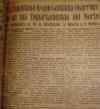
|
July 7, 1929.
"Es Espantoso lo que Continúa Ocurriendo en
los Departamentos del Norte —
Por Dondequiera se Ve la Destrucción, la
Miseria y el Hambre," El Comercio (Managua).
"Pedrón
merodea a 3 leguas de Jinotega
¶
Personas de resonsibilidad que acaban de
llegar a esta capital, han proporcionado
informes que revelan con claridad la
espantosa situación que continúan sufriendo
los Departamentos del Norte, en donde —
hacia cualquier lugar que se dirija una
mirada — tan sólo se contemplan cuadros de
destrucción, escenas lastimosas de miseria y
de hambre y de obras calamidades, que los
los frutos dolorosos de asesinato y del
pillaje que viven soportando aquellos
moradores. ¶ A 3 leguas de Jinotega, poco
más o menos, merodea con su gente el célebre
Pedrón. Pocos días hace que pasó por
Saraguasca, cogiendo hacia el Norte, por el
lado de Tumayunca. A su paso, las haciendas
quedan saqueadas, las casas quemadas y
reinando por doquiera la desolación y el
espanto. ¶ El último asesinato: un
anciano ¶ Pocos días hace también
que asesinaron por esos lugares a un anciano
de apellido Blandón, a quien dieron muerte
de la manera más cruel, sin prestar oidos a
sus quejas y súplicas lastimeras, pidiendo
que los dejasen con vida e implorando
misericordia en el nombre del Cielo y de
Dios. ¶ En el indefenso anciano se cebo la
furia pedroncista, que en estos últimos días
ha continuado con más fuerza su obra de
exterminio, sembrando de cadáveres aquellas
regiones. ¶ Pero nadie sale a
batirlos ¶ Se sabe positivamente
que Pedrón cuenta con no menos de doscientos
hombres bien equipados, una parte de los
cuales permanece en el valle de Los Cedros,
situado en aquellos mismos alrededores. ¶ Lo
anterior lo saben bien los americanos y la
guardia. Pero nadie sale a batirlos, por
miedo o por lo que sea. ¶ Esa actitud
incomprensible da alas al bandolerismo, que
sin sufrir persecución se multiplica
alarmantemente, de tal manera que, si esa
inferencia persiste, la ola del crimen se
levantara amenazante sobre otros
departamentos. ¶ Son reconcentrados
en Yalí ¶ Son gentes pobres en su
casi totalidad, campesinos que antes
disfrutaban de una relativa comodidad y que
ahora permanecen reconcentrados en Yalí,
donde se les ha dejado abandonados a su
propia suerte. Sus propiedades fueron
aniquiladas, sus ranchos incendiados, sus
graneros deshechos; y ahora ambulan sin pan,
sin abrigo y sin hogar. ¶ Han sido
reconcentrados por las fuerzas que comanda
el general Escamilla, sin que el gobierno se
preocupe de la suerte de esos desgraciados.
¶ Es horroroso todo lo que por allá esta
ocurriendo. Nada esta seguro: ni la honra,
ni la vida, ni la hacienda. ¶ Quien nos daba
estos informes, nos decía por último: ¶ —Es
muy seguro que el señor Presidente Moncada
desconozca la verdadera situación de
aquellos departamentos. De otra manera, ya
habría dado pasos seguros para remediarla,
como buen militar y ciudadano de honor, que
es."
|
|
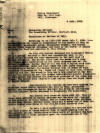
|
July 8, 1929.
"Conditions of Natives of Yali," Lt. A. T.
Lewis, Yali, to Northern Area Commanding
Officer, Ocotal, p. 1.
" . . . 1. Referring
to my 1103-1109 dated July 3, 1929, this
recommendation was based on inspections of
the houses in Yali by the Alcalde,
Lieutenant Levis, Lieutenant Troxell, and
myself and the local Hospital Corpsman, and
also by the number of people applying for
food and medicine to this office. ¶
2. On July 4th Doctor Marchand and
Lieutenant Harris (with a patrol) arrived in
Yali and immediately went to the homes of
the natives who were apparently in the most
need of medical attention. The doctor found
that the woman whose case was diagnosed as
appendicitis by the local corpsman was not
the correct diagnosis. In the case of the
man with a bullet hole thru the left
shoulder joint and left thumb and left index
finger shattered by a bullet, the doctor
decided that it would be only necessary to
operate on the thumb and finger at this
time, without removing the arm. The wound to
this man’s arm occurred on May 25th and has
not healed up yet. The doctor administered
general anesthetic to this native and
removed the shattered portions of the thumb
and finger. The doctor also removed a lead
bullet from the right cheek of Miguel
Salgado. ¶ 3. Approximately two
hundred natives have applied for treatment
since Doctor Marchand has been in Yali.
Lieutenant Harris, who accompanied Doctor
Marchand has acted as interpreter and has
assisted Doctor Marchand in diagnosing the
applicants. ¶ 4. Six deaths have
occurred since July 4th. Four of these were
examined by Doctor Marchand and two were not
reported to him previous to their deaths.
Two of these were young children of the same
family, another small child and a woman all
of whom the doctor stated were dying at the
time he first observed them. ¶
5. To date I have endeavored to have the
natives that had food donate to those
without food to avoid issuing food to the
general public. Twenty-five dollars’ worth
of medicine has been purchased from a local
merchant upon the recommendation of the
Battalion Surgeon. . . "
Note: On
Dr. John Louis Marchand of Bluefields, and
his vigorous public opposition to the US
intervention, see the East Coast pages, or
search "Marchand".
|
|
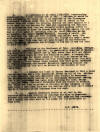
|
July 8, 1929.
"Conditions of Natives of Yali," Lt. A. T.
Lewis, Yali, to Northern Area Commanding
Officer, Ocotal, p. 2.
" . . . 6. In
reference to my radio 1108-1039,
recommending employment for former bandits
now in Yali, I believe it would be more
advisable for these men to be employed by
the Nicaraguan Government building roads
than to allow them to return to the Pavona
Area and rejoin the bandits. Several men
have applied to me to work for the marines
for food for themselves and families and
have stated that they had formerly worked
picking coffee in the San Antonio-La Rica-La
Pavona area during the season but now had no
other means of providing food for their
families except as bandits. One native
ISABEL CASTILLO, formerly a bandit, how in
Yali with his wife and five children applied
for work. His wife died last night of
malnutrition. She stated she hadn’t eaten
for four days. This case had not been
brought to our attention until yesterday
afternoon and although we fed her it was too
late to save her life. ¶ 7. The
area to the Northeast of Yali, including
COYOLAR, RIO ARRIBA, SAN ANTONIO, and etc.,
is practically deserted at present. The
women from those places now in Yali state
they will not return to their homes there as
they are required to make a hundred
tortillas at a time for bandit bands or they
will be beaten by the bandits passing thru.
Several men from those areas state they will
not return to their former homes because
they have given testimony to Captain
Hanneken and General Escamilla regarding
bandits and have been notified they will be
killed by the bandits if they leave Yali.
¶ 8. I believe the visit of Doctor
Marchand to Yali a treat the natives has had
a very beneficial effect on all of the
natives of this vicinity, who have
heretofore been hostile to Americans. The
natives are still hostile to the Nicaraguan
Government stating that their Government has
never done anything for them, except to
collect taxes, has never furnished them any
doctor or schools, etc. There has been no
priest or minister of any religion in this
area since I have been here and the natives
state they can’t afford one as a visiting
priest assesses them too much. ¶
9. General Escamilla stated to me that he
had reported to the Jefe Politico at
Jinotega and also to President Moncada the
conditions existing in the Yali area and has
recommended a school and also work on the
roads for the ex-bandits in this area.
¶ A. T. LEWIS."
|
|
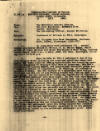
|
July 12, 1929.
"Treatment of Natives in Yali, Nicaragua,"
Battalion Medical Officer, 2nd Battalion,
11th Regiment, 2nd Brigade, Pueblo Nuevo, to
Northern Area Commander, Ocotal, p. 1.
"Reference: (a)
Telegram from Area Commander, Northern Area,
Ocotal, Nicaragua, 1103-1711. ¶
1. In compliance with Reference (a), myself,
Second Lieutenant Harold D. Harris, U.S.
Marine Corps, and a patrol of eight marines
and Chief Pharmacist’s Mate Young, cleared
Pueblo Nuevo, 6:30 a.m., 4 July, 1929, for
Yali Nicaragua, arriving there at 5:30 p.m.
¶ 2. Upon arrival at Yali I examined a
few of the more serious cases including the
reported operative cases that night. The
woman reported having appendicitis and
requiring operation I diagnosed as having a
mild case of dysentery. She had a mild
diarrhea without blood, had generalized
abdominal pains and a slight elevation of
temperature. No vomiting, no history of
previous attacks. She was treated as a
dysentery case and on the third day she was
out of bed walking around and feeling much
better. Goyo Perez [Gregorio Pérez], the man
reported as requiring amputation of the
shoulder joint was examined that same night.
He had been shot about a month ago in the
left shoulder and a second shot injuring the
finger and thumb of the left hand. The
bullet injuring the shoulder had evidently
entered from the posterior passing through
the infraspinatous portion of the scapula
and exiting in the anterior about two inches
below the external end of the clavicle. The
wound of entry was healed at the time of
examination but the wound of exit was still
discharging a small amount of
sero-sanguinous fluid. I do not believe the
bullet penetrated the shoulder joint.
However the upper third of the humerous had
evidently been fractured, but was well
knitted and in fair position at this time.
As there was a fair amount of abduction,
rotation and amount of infection, shoulder
joint amputation was not considered
necessary. However, the left thumb and
phalangeal joint was badly injured and
infected, amputation was advised and finally
consented to by the patient, and performed
distal to the metacarpal phalangeal joint
under ether anesthesia. . . . "
|
|
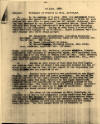
|
July 12, 1929.
"Treatment of Natives in Yali, Nicaragua,"
Battalion Medical Officer, 2nd Battalion,
11th Regiment, 2nd Brigade, Pueblo Nuevo, to
Northern Area Commander, Ocotal, p. 2.
"
. . . ¶ 3. On the morning of 5 July,
1929, the unoccupied house of the padre was
opened and used as a dispensary to which all
sick natives who were able to come reported
for medical treatment, having been summoned
by the Alcalde. Lieutenant Harris, Chief
Pharmacist;s Mate Young and Pharmacist’s
Mate third class Bannister assisted in the
dispensary. During my stay there I treated
190 cases that were brought to my attention.
These illnesses were divided roughly into
three large groups: ¶ (a)
Intestinal disturbances, including
dysentery, diarrhea, constipation ascariasis
(many of the children had the later) 145
cases. ¶ (b) Fever (calenture)
21 cases ¶ (c) Miscellaneous,
including ulcers, skin infection, headache,
syphilis, etc. 24 cases. ¶
Drugs, including castor oil, santonin,
quinine sulphate, bismuth, subnitrate, and
tincture of camphorated opium, were
purchased from a native store to the value
of twenty five dollars. Other material such
as gauze, cotton, bandages, legerature,
material, etc., were used from the Medical
Department here. ¶ 4. During my
stay there of four days and five nights six
natives died, four of which I had seen and
treated and two of which I did not see as
they did not report to the dispensary and
their illness was not reported to me.
¶ 5. Another minor operation was
performed on one Miguel Salgado, who had
been shot two years previously. The bullet
had entered the face at the right lateral
aspect of the nose and had lodged just under
the skin, anterior to the right superficial
temporal artery and superficial to the
zygomatic process of the right malar bone.
The wound of entry was healed nicely, no
infection present at site of entry or at
site of extraction. Bullet extraction and
wound sutured with catgut. ¶ 6.
The cause of the sickness in Yali,
Nicaragua, is believed to be due to the
unhygienic living conditions and
insufficient food and shelter at the time of
the concentration there. The natives are
gradually building new thatched houses, some
few have left the village so that the living
conditions are slowly being altered. The
food supply seems to be adequate in . . . "
|
|

|
July 12, 1929.
"Treatment of Natives in Yali, Nicaragua,"
Battalion Medical Officer, 2nd Battalion,
11th Regiment, 2nd Brigade, Pueblo Nuevo, to
Northern Area Commander, Ocotal, p. 3.
" . . . quantity for
the most part of the present. The native men
are appealing to the Marines for work. As
the death rate had definitely decreased,
medication had been instituted to the sick,
and still is available, my presence there
was no longer deemed necessary. Our patrol
cleared Yali at _:30 a.m., 9 July, 1929,
arriving Pueblo Nuevo at 4:00 p.m. same
date. ¶ 7. Recommendations:
¶ (a) That the natives refugees be
encourage to return to their farms as soon
as the bandits situation permits . ¶
(b) The native doctor be furnished Yali
during the concentration. ¶ (c)
That no subsequent concentrations occur
without previous provision for adequate food
and shelter."
|
|

|
July 12, 1929.
"El Gral. Plata ya tomó posesión,"
El Comercio (Managua).
"Don David Pereira,
Director de Comunicaciones, recibió un
telegrama del General Alejandro Plata,
participándolo haber tomado posesión del
cargo de Gobernador de San Marcos de Colón."
Notes & Comments:
Seven months after his initial commission by
property owners of Jinotega, the Honduran
General Plata is appointed by the Honduran
government as "Gobernador" of San Marcos de
Colón west of Somoto. Now Plata &
Caldera both have jobs in Honduras.
|
|
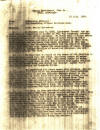
|
July 15, 1929.
"Local Native Situation," Commanding Officer
Lt. A. T. Lewis, Yali, to Northern Area
Commander, Ocotal, p. 1.
"1. On Tuesday July 9,
1929, Lieutenant Troxell and myself made an
inspection of houses in Yali and temporary
thatched shacks occupied by native refugees.
We found many of these shacks occupied by
women and children. Some of these families
had a little corn to make tortillas with but
we found no other food. We purchased rice
and beans from local merchants of Yali and
had the Alcade, the Telegraph Operator and
the Chief of Police issue this corn and
rice, under the supervision of Lieut.
Troxell and myself to refugee families of
women and children, who had no men to
provide for them. ¶ 2. We have
kept a record of the names of all families
to whom we have issued rice and beans, the
total number of women to whom we have issued
food is 48. The total number of women and
children issued food is 219. Our records
show these families to be from Pavona Area,
Rio Arriba and Coyolar, mostly and a few
from Achotales and Quebrada Arriba. ¶
3. We questioned all these women with
children, who had no men folks with them as
to the whereabouts of their husbands and we
were unable to get any definite answers
except in one case. This case is three women
with six children living in one small thatch
hut, who claim to be from La Pavona Area.
They all claim they are not married and have
no “Matrimonies”. We enquired if the fathers
of their children were bandits and these
women claimed they didn’t know, but
possibly. This case, I believe, illustrates
the type natives we have in this area.
¶ 4. To date, we have purchased
medicines amounting to twenty-five dollars
($25) and issued to sick natives of Yali.
The amount does not include any U.S.M.C.
supplies, such as gauze, Aspirin and etc.
which were issued by Dr. Marchand and also
Medical supplies of the U.S. which were used
by Dr. Marchand in his operations. Only five
natives had died since July 8th. (One woman
and four children.) We are still issuing
castor oil from the supply originally
purchased to sick natives. As the majority
of natives were dying from an epidemic of
Diarrhea and malnutrition, I believe the
visit of Dr. Marchand and Lieutenant Harris
(who was very valuable as an interpreter)
has stopped the epidemic before it spread to
this detachment. (We have no cases of
diarrhea among the marines.) . . . "
|
|
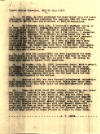
|
July 15, 1929.
"Local Native Situation," Commanding Officer
Lt. A. T. Lewis, Yali, to Northern Area
Commander, Ocotal, p. 2.
" . . . ¶ 5. To
date, we have purchased and distributed rice
and beans amounting to $45.50 and including
the medicine ($25.00) have spent a total of
$70.50 from the Allotment of $200.00
authorized. ¶ 6. On Wednesday
July 10th, I observed a stranger coming in
to Yali from the North, riding one mule and
leading another. As he proceed direct to
Sra. Carilda P. Chabarria’s house (the wife
of Pedro Blandon) and spoke to her a few
minutes, I suspected he might be a messenger
from Blandon so interviewed him and he
claimed to be Juan Aguilar from Las Guayavas
and had a passport to that effect. The
Alcalde and the Chief of Police of Yali
identified him as Juan Aguilar. As I have
not this man’s name on my list of Bandit
suspects in this area I had no reason to
apprehend him. He immediately left Yali, to
the West. I am reporting this incident in
case the Regimental Intelligence Officer may
have this man’s name listed. ¶
7. To date two hundred (200) men have
registered for work. All of these men keep
inquiring as to when they will be able to
start work and how much they will be paid a
day. Of course we have been unable to answer
their questions. ¶ 8. On Friday,
July 12, 1929, Lieutenant Levie, with a
patrol, proceeded on a mapping detail of the
Coyolar-Rio Arriba area. He reported the
area deserted but that at one house in
PACOYAL, (a group of houses between Coyolar
and Rio Arriba) he found a hot native stove,
showing that someone had been there and had
fled on the approach of the marines. ¶
9. Natives of Yali who have formerly
volunteered information when bandits were
operating in this area, claim that there
have been no bandits in this area since the
Hanneken-Escamilla patrol left on June 20th.
¶ 10. There are still about 200
refugees (including men, women and children)
located in the refugee camps outside of
Yali. One camp is a mile and a half North of
Yali and the other camp extends East from
Yali to the Sugar Mill. I questioned many of
these refugees as to why they did not return
to their own homes and their answers were
about evenly divided, some said they were
afraid of bandits and the others said that
General Escamilla would not let them go
back. The Alcalde who was with me when I
questioned these natives, stated to me that
General Escamilla did not want certain of
these natives to return to their homes.
¶ A. T. LEWIS"
|
|
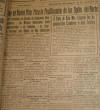
|
July 18, 1929.
"Hay un Nuevo Plan Para la Pacificación de
los Dptos del Norte — Hará
Levantado un Ejército de Voluntarios
Nicaragüenses — Los Marinos
Americanos Serán Reconcentrados a las
Ciudades — La Guardia Nacional
será Objeto de Una Reducción," El
Comercio (Managua).
"De un momento
a otro será puesto en ejecución.
¶ En fuente suficientemente autorizada
se nos informó ayer, que entre el Gobierno y
los jefes principales del ejército
norteamericano de ocupación, se ha convenido
en un nuevo plan para proceder a definitiva
pacificación de los Departamentos del Norte,
[--]ciada por el bandolerismo. Los detalles
de ese plan es- [--] iendo ultimados y de un
momento a otra será puesto en ejecución.
¶ Ejército nicaragüense de 2 a
3 mil hombres ¶ La
esencia del plan es dejar el campo a los
nicaragüenses, para que ellos impongan la
[---] en aquellos Departamentos. ¶
Será levantado un ejército de dos mil o tres
mil voluntarios, según sean las necesidades,
que irán con la con [---] a de acabar con el
bandolerismo, persiguiéndolo y [---]iéndolo
hasta en los más [---]riados rincones de las
montañas norteñas. ¶ También los
jefes serán nicaragüenses ¶ El
jefe principal, así como [--]os los demás,
también de[----]n ser nicaragüense. Su
[--]gencia será hecha entre [---] militares
caracterizados [por] su valor y hombría de
[---]n, a fin de asegurar el éxito de la
campaña, al mismo tiempo que la tranquilidad
de que son acreedores los ha[---] antes de
aquellas regiones. ¶ A
eso se debe el regreso de Escamilla
¶ En nuestra Ultima Hora de ayer
informamos que llegaría de un momento a otro
a Managua, en un avión de ejército
norteamericano, el
General Juan Escamilla,
jefe que ha sido de las tropas
expedicionarias que han actuado en Jinotega
y Nueva Segovia. ¶ El regreso de
Escamilla ya es parte del plan a que nos
venimos refiriendo, pues no siendo él
nicaragüense, no le podrá ser confiada la
jefatura del nuevo ejército que será
levantado. ¶ La
reconcentración de los marinos
¶ Al mismo tiempo que las columnas de
voluntarios vayan llegando al Norte, los
marinos americanos irán evacuando los
distintos lugares ocupados, reconcentrándose
a las ciudades principales de aquella zona,
o al interior de la República. . . . ¶
Fue el resultado de la conferencia
con el Admirante Campbell ¶
Lo que ocurre es que los jefes
norteamericanos han llegado al
convencimiento de quela permanencia de los
Marinos en el Norte resulta ineficaz para
exterminar al bandolerismo. Su modo de
operar es completamente distinto al nuestro,
mientras que el soldado nicaragüense conoce
naturalmente todas las artimañas del
connacional. ¶ Sabemos que este
punto de vista fue contemplado durante la
conferencia habida en la Legación Americana,
a la que concurrieron el Almirante Campbell,
los generales Williams y McDougal y otros
jefes importantes, tomándose la
determinación de dejar el campo libre a los
nicaragüenses para que ellos hagan la
pacificación. ¶ La
Guardia será reconcentrada y reducida
¶ También las compañías de la Guardia
Nacional, que operan en el Norte, serán
reconcentradas al interior. ¶ En
dicho cuerpo se hará una importante
reducción, en compensación de los gastos que
ocasionará el ejército de voluntarios.
¶ El jefe más probable
¶ Se citan los hombres
de varios generales ya quienes pueden ser
confiada la jefatura del ejército; pero el
que figura con más probabilidades es el
General Carlos Pasos, en quien se consideran
reunidas todas las condiciones para el caso
presente."
Notes & Comments:
A mostly accurate prognostication of the end
result -- a Nicaraguan army led by
Nicaraguans -- but a garbled interpretation
of how US policymakers hoped to get there.
The article was occasioned by the big
"conference" in the US Legation in Managua
among the chief strategists of the US
intervention (Campbell, Williams, McDougal &
others). It is not known whether the
reporter was fed the wrong information, or
did not understand what he was told.
In either case, the story reveals a deep
uncertainty about the role US policymakers
envisioned for the Guardia Nacional, even
among the lettered & informed classes.
Notably, Escamilla was active till now
(mid-July), but these were his last
days as a Voluntario general. Soon
after he was appointed to supervise road
construction projects in Jinotega.
|
|
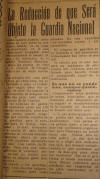
|
July 19, 1929.
"La Reducción de que Será Objeto la Guardia
Nacional," El Comercio
(Managua).
" . . . El número de
guardias será reducido a mil doscientos.
Actualmente hay cerca de dos mil. . . .
Notes & Comments:
We see here a continuation of the core
dynamics that led to the creation of Los
Voluntarios in the first place: the
fiscal incapacity of the national state to
adequately fund the Guardia Nacional (and in
part as we see here, the US intervention) at
the level needed to counter the Sandinista
rebellion.
|
|
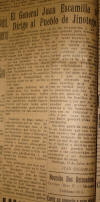
|
July 19, 1929.
"El General Juan Escamilla se Dirige al
Pueblo de Jinotega," El Comercio
(Managua).
"Teniendo informes que
en esta población existen algunas personas
que se han llegado a la persona del Señor
Presidente, diciendo que soy más temible que
el bandolero Pedrón. No sé cuales sean las
causas que tengan esas personas, para
denigrar mi honra, ya sea personal o
militar; pues todo lo contrario, deste que
he pisado las tierras de este Departamento,
cosa que no deben negar, se ha sentido un
algo de tranquilidad, no sentida antes de mi
arribo a este lugar. ¶ Así,
pues, señores, no sé cuales sean los hechos
que tanto os horrorizan, talvez sean las
garantñas que por todas partes he venido
impartiendo, por cuya razón señores, espero
sean más justos y equitativos en sus
aseveraciones. ¶ También les hago
saber a esas personas que se han declarado
enemigas mia o de mi columna, que lejos de
estar haciendo viajes a Managua con chismes
infructosos, les recuerdo el deber como
patriotas y buenos nicaragüenses, de poner
todo su contingente para llevar a feliz
término esta pacificación y no gastar su
tiempo en inútiles lamentos. ¶
Esas personas que han mal gastado su tiempo
en ir hasta Managua a dar unos informes que
son de todo punto falzas; como no dijo ese
señor que por espacio de 13 días en Yalí
fueron socorridas las familias
reconcentradas, con el dinero que el
Gobierno autorizó para gastos de los
voluntarios, y que ha sido gastado para
socorrer dichos reconcentrados. ¶
Si tanto sienten la suerte de esos
desgraciasos ¿por qué no corren a
socorrerlos? Pero con hechos y no con
palabras; ues estas no sierven para nada que
sea material, que es de lo que más necesitan
esos desgraciados. Esto refiriéndome a un
artículo que aparece en ‘La Noticia’ del
siete del corriente, y que también informa
diciendo son todas esas familias muy pobres,
eso es verdad; pero no dice la necesidad que
hay de hacerlo así, pues en su mayor parte
son las familias de los bandoleros y los que
no son, ayudan con proveer de alimentos a
los bandoleros ya sean con su voluntad o sin
ella, y por cuya razín hay que hacer general
dicha concentración. ¶ En otra
parte de este artículo he hablado que son
varias (son cuatro) las personas que se han
ocupado de mis actos, pero ya son de mi
conocimiento, y vuelo a decirles que lo
mejor que pueden hacer es unirse a las
autoridades para ayudarles y no declararse
enemigas de ellas. ¶ Jinotega,
13 de Julio de 1929. ¶ JUAN
ESCAMILLA."
Notes & Comments:
Escamilla's self-defense here rings hollow,
but another indication that these were
his last days as a Voluntario general.
|
|
_small.jpg)
|
July 19, 1929.
"La Pacificación"
La Tribuna (Managua).
"Preguntámos al doctor Bernardo
Sotomayor, si era cierta el rumor de que el
gobierno levantaría un ejército de tres mil
hombres para la pacificación de los
departamentos del Norte, contestó que hasta
la fecha no se había dispuesto nada sobre el
particular; que posiblemente la Guardia
Nacional será la encargada de la completa
pacificación de aquella zona."
|
|
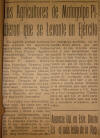
|
July 21, 1929.
"Los Agricultores de Matagalpa Pidieron que
se Levante un Ejército," El Comercio
(Managua). "En
aquella ciudad tuvieron una reunión los
siguientes agricultures: señores Carlos
Potter, Juan Danies, Agustin Franemberger,
Francisco Somarriba, Eudoro Mantilla,
Roberto D. Amort, Rubén Jaen, Francisco
Navarro, Otto Kühl, Félix Pedro Aráuz,
Hernán Delgado, Agustín Montes, José Vita,
Vicente Morales, Raymond Hawkins y James
Haslam. Después de deliberar sobre la
amenaza de bandolerismo, acordaron dirigir
un telegrama al señor Presidente Moncada,
del cual son los siguientes conceptos. ¶
‘Tal como van desarrollándose aquí las cosas
nos será imposible atender nuestros
haciendas y llevar a cabo los trabajos
indispensables para la preparación y
recolección de la próxima cosecha de café,
lo que ocasionará la ruina de Matagalpa. Los
suscritos agricultores rogamos a Ud. muy
encarecidamente dictar enérgicas medidas, no
tomadas hasta ahora, que nos salven de tan
terrible situación y nos permitimos
insinuarle la conveniencia de autorizar al
Jefe Político de este Departamento para que
levante un pié de ejército, en número
suficiente, para proteger las zonas
bandoleros, o disponer de cualquier otra
medida eficaz que esté a su alcance y pueda
poner término a la situación por que
atravesamos. Ofrecemos a Ud. franca y leal
cooperación. Confiamos en que Ud. se dará
cuenta de la justicia que nos asiste y
accederá a nuestra petición.
Notes & Comments:
Included here to illustrate the same
pressures that led to the creation of the
Voluntarios to begin with: rebels'
"patriotic plunder" of property holders --
especially large coffee growers -- prompting
property holders to petition the national
state to protect their properties.
|
|
_small.jpg)
|
July 24, 1929.
"Escamilla y el
pueblo de Yalí," La Tribuna
(Managua). "La
población de Chinandega con toda propiedad
ha sido calificada en general como el pueblo
mártir de la Revolución. Yalí lo será
también como el pueblo mártir de la
Pacificación, con la diferencia de que
Chinandega volverá a ser lo que fue, será
reconstruida y tal vez con más esbeltez, con
más armonía. El pueblo de Yalí perecerá en
masa y desaparecerá irremisiblemente del
mapa de Nicaragua. Yalí es un pueblo
esencialmente agrícola, laborioso, humilde,
con vida propia y sus labores agrícolas de
preferencia son el cultivo de maíz, trigo y
arroz que se cosechan admirablemente; pero
con especialidad sus habitantes se dedican
al cultivo de caña y el café que en ciertas
regiones se desarrolla con prontitud y da
muy buenos rendimientos. Se calcula su
cosecha anual en no menos de seis mil
quintales de café. Las malas vias de
comunicación con que cuenta han sido la
causa principal de que no hay progresado lo
que debera. Sin embargo, puédese afirmar sin
temor a equivocarse que es el pueblo más
rico del departamento de Jinotega. ¶
Este pueblo laborioso y humilde, en otro
tiempo contento y satisfecho con la alegría
que produce al labriego el cultivo y
recolección de los frutos que da la tierra a
manos llenas, hoy se encuentra sumido en la
mayor desgracia y desesperación,
reconcentrados todos sus habitantes, mejor
dicho, hacinados en ese pequeño pueblo con
treinta y dos casas de población, con clima
lluvioso, húmedo y frio, sin alimentación
suficiente, faltos de abrigo y expuestos a
la intemperie, no es de extrañar que se
cuenten por centenares los que han muerto
especialmente niños y sin duda alguna
perecera toda la población si no se pone
pronto, inmediato remedio a situación tan
crítica y dolorosa. ¶ Nunca
hemos crído – contra el sentir del elemento
oficial – que la pacificación de las
Segovias llegara a ser efectiva con la
reconcentración de los campesinos a los
pueblos. Llevamos ya cuatro meses de
reconcentración iniciada por Plata, ¿qué
resultados prácticos se han palpado? ¿Qué se
ha adelantado tocante a la pacificación?
Nada absolutamente. Sus resultados han sido
más bien contraproducentes. Las filas de los
bandoleros se han engrosado, pues unos
huyendo de la persecución sistemática y
ciega de que han sido objeto y otros al ver
sus casas incendiadas, llevados de odio y la
indignación por verse en la miseria, han
optado por el bandolerismo creyéndose
también más seguros con el rifle en la mano.
¶ Pero si la reconcentración se
considera indispensible, necesaria para la
pacificación, ¿porqué no haber dado un
tiempo razonable a esas pobres gentes para
haber trasportado a otra parte sus familias,
sus viveres, sus animales, etc. Etc., lo
poco que posee un pobre, pero que sin ello
es más desgraciado fuera de su hogar? ¿O
acaso se cree que en breve tiempo se
pacificará esa zona? Error crasísimo. ¿Qué
harán esas familias en año entrante con sus
cosechas de maís perdidas, sus fincas
acabadas por la acción del tiempo sin cuido
alguno, pastando el ganado en sus cañales,
etc.? ¿Con qué elementos de vida podrán de
nuevo volver a sus hogares – muchos de ellos
incendiados por Escamilla – y volver a
trabajar el día de mañana sin nada de lo
indispensible para la vida? ¶ Al
pueblo de Yalí lo consideramos
imposibilitado para rehacerse. Y pensar que
tan brutal proceder se intente llevar a
práctica con otros pueblos da horror y
lástima solo el pensarlo. Quien hubiera
presenciado ese éxodo de familias con sus
pequeños hijos, sus pobres ajuares, sus
enfermos y hubieran visto a una madre
inconsolable que tuvo la desgracia y
necesidad imperiosa de enterrar sobre el
camino real a uno de sus hijos y otro
gravemente enfermo que lo llevaba en un
caballo muriósele también en el camino
teniendo ya difunto que amarrarlo a lo largo
en el caballo y en esa actitud cayéndose los
brazos y cabeza a uno y otro lado del
caballo, desencejado y lívido su rostro
entró con él al pueblo de Yalí, quien
hubiera presenciado repito este y otros
casos pudiera medir la gravedad de una
reconcentración y sus desoladoras
consecuencias. ¶ Ahora bien,
quién es el responsable de tantas
desgracias? Pudiérase culpar a Escamilla por
el simple hecho de la desocupación? No. El
pueblo segoviano sabe muy bien que Escamilla
es el medio de que se ha valido el
Interventor para llevar a cabo estas y otras
hazañas. Pero las Segovias enteras le acusan
de cruel y inhumano por el proceder con que
las ha llevado a la práctica. Es un militar
mercenario que por un vil puñado de plata es
muy capaz de sacrificar no digamos la
Segovia sino el país entero si se lo
ordenaran! Y que le puede intercaer,
extranjero irresonsable como es, de que el
país perezca, sufra y se vea sumido en
desgracia irreparable; con tal de tener
contento a su amo y protector, no le importa
a él que el país se hunda. ¶
Dice Escamilla en un su panfleto dirigido al
pueblo de Jinotega que son cuatro las
personas que se han ocupado de criticar sus
actos ante el señor Presidente Moncada
diciéndole que Escamilla es más bandolero
que Pedrón, etc. etc. Se ha quedado muy
corto Escamilla en el número y la
comparación no puede ser más exacta. No son
cuatro los vecinos de Jinotega que le han
puesto en evidencia y declarado como es en
sí, es el pueblo todo, es la Segovia entera
que tiembla ante el solo nombre de este
militarote sanguinario, déspota, cruel e
inhumano. Ricos y pobres lo consideran todos
en general como una amenaza. Qué hablen las
cárceles de Jinotega llenas de seres
inocentes sacados de sus propias casas para
llevarlos como trofeo de sus viles
victorias, acusándolos de delitos
imaginarios, seres desgraciados que aun
están sufriendo como míseros esclavos
trabajando como bestias de carga bajo el
látigo amenazador del interventor. ¶
Que hablen la Iglesia de Yalí y sus santos
en cuyas soleras fueron colgados muchos
inocentes apaleados y martirizados con lujo
de crueldad. Que hablen los soldados de la
columna de Escamilla y digen cuántos han
sido fusilados combardemente en las montañas
de Yalí y Jinotega sin formación de causa,
por simples suposiciones o denuncias,
gratuitas. Nosotros sabemos por ellos mismos
que el número de fusilados asciende a
vienticinco. Veinticinco viudas llorando
inconsolables. Cien niños en la orfandad. He
ahí la obra pacificadora de Escamilla! Cómo
no va a ser más temible y comparable a
Pedrón si le supera en crueldad y la riqueza
destruída por Escamilla es incalculable,
habiendo dejado en la orfandad y la miseria
a miles de familias? No, no son cuatro los
que claman contra el feroz Escamilla; es
Jinotega todo, es la Segovia entera que
considera la presencia de Escamilla en el
país como un bochorno para el gobierno
teniéndo a su servicio y como una vergüenza
para Nicaragua. ¶ Y que diremos
de las grandes victorias de Escamilla contra
los bandoleros los verdaderos bandoleros
portadodres del rifle! El contaba con gran
énfasis que ha matado a centenares, que ha
visto incrustados los sesos de bandoleros
hasta los árboles de las montañas más
oscuras (por la misma oscuridad no podrá
comprobarse). Que ha dejado reguero de
sangre de los heridos por todas las montañas
que se ha perdido hasta ocho días
consecutivos en una áspera montaña,
salvándolo la proximidad del río Coco y el
aparecer alegre de los inocentes avianes que
le pusieron en el buen camino. ¶
Estas y otras farándulas son alegremente
referidas por él mismo, mas la verdad, la
pura verdad es, que está por comprobarse la
muerte del primer bandolero portador de
rifle muerto en combate y el primer rifle
arrebatado como botín de guerra. Escamilla
se ha lucido pero con la inocencia, la gente
desarmada, la gente humilde y trabajadora,
pero qué lucidez tan negra y apetecida solo
por el que ha salido del hampa y la basura.
¶ Señor Presidente Moncada, para
llevar a buen fin la pacificación del país
lo primero que se necesita es contar con un
General responsable, valiente y de honor,
mientras tanto le pedimos ponga en libertad
a tantos desgraciados que tienen recluidos
en la cárcel obligándonos a trabajar todo el
día brutalmente, sin sueldo y pésima ración,
faltos de ropa y caizado y más que todo
porque son a todas luces inocentes,
arrebatados de sus propias casas o
trabajando en sus labores. ¶ Es
una injusticia que se sacrifique al pueblo
de ese modo. Si el interventor quiere hacer
mejoras en Jinotega sobran operarios
pagables para hacerlas. Valerse de
subterfugios viles para llenar las cárceles
y tener esclavos disponibles es impropio del
siglo XX. ¶ Un Segoviano,
Jinotega, 20 de julio de 1929."
Notes & Comments:
This long but vague set of accusations is
essentially accurate, as we see in the
surrounding Marine-Guardia documents, but
offers little specific evidence in support
of its claims, in keeping with the norms of
Nicaraguan journalism during this period.
It is noteworthy that neither Hanneken nor
Lee figure in this catalog of victimization.
|
|
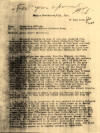
|
July 27, 1929.
"Local Native Situation," Commanding Officer
Lt. A. T. Lewis, Yali, to Northern Area
Commander, Ocotal, p. 1.
" . . . 1. Enclosed
herewith is copy of telegram received from
Managua requesting that we issue orders
preventing families of bandits from leaving
Yali. The Alcalde of Yali also received a
similar telegram, and as all persons are
required to secure passports from the
Alcalde no members of bandits families have
been permitted to leave Yali since
General
Escamilla was here
on June 20, 1929. ¶ 2.
This office has expended, from the $200.00
allotted, for the relief of sick and
starving natives, $25.00 for medicine and
$97.50 for corn, beans and rice, or a total
of $122.50 to date. I have discontinued
issuing food at present to the poor families
as I believe the number of men now employed
on road work and receiving pay will be able
to help out the families who have no men
working on the roads. The total women and
children to whom we have issued food is 219.
These were divided daily by the Alcalde and
Chief of Police under the supervision of a
Marine Officer who recorded the names and
former residences of these natives. Since
the visit of Fr. Marchand and the medicines
given, instead of an average of five deaths
per day there have only been three deaths
during the past week and there is presently
no dysentery or diarrhea in Yali at present.
The new roads starting out of Yali have
drained the street toilets. ¶ 3.
The families of Pedro Blandon and Centeno
did not apply for food to us as they have
had credit established for them at Gonzales
store. ¶ 4. In making my
inspection of the quarters of native
refugees I enquired why they did not go back
to their homes or to Esteli or Jinotega as I
had no orders then to hold them, and their
answers were invariably that
General Escamilla directed them not to leave
Yali until he notified them.
Lately men that served with
General Escamilla’s volunteers have been
disbanded and returned to Yali and notified
the natives that Escamilla is no longer in
the field. The bandit class in this area
fear General Escamilla more than they do any
one else in Nicaragua and the
good citizens respect him. I believe it
would have a good morale effect for General
Escamilla to make another patrol thru this
area, but would recommend his escort to be
GUARDIA instead of VOLUNTEERS. . . . "
Notes & Comments:
My emphases. It appears that
Escamilla's last visit to Yalí was on June
20, and that his Voluntario army was
disbanded after the big conference at the US
Legation in mid-July. The legacy of fear he
left behind seems palpable. He was soon
appointed to supervise road construction
projects around Jinotega.
|
|
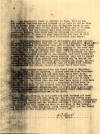
|
July 27, 1929.
"Local Native Situation," Commanding Officer
Lt. A. T. Lewis, Yali, to Northern Area
Commander, Ocotal, p. 2. "
. . . ¶ 5. An unreliable rumor is
current in Yali, that as the bandits
families are not allowed to go back to the
La Rica and La Pavona area, the bandits plan
to explode bombs on one side of Yali which
will be the signal for families of bandits
to leave Yali and the bandits will then
attack the Marine garrison. Judging from
their past experiences in attacking a Marine
Garrison it does not seem reasonable for
them to want to commit suicide, therefore I
have discounted this rumor. ¶ 6.
From information received of ex bandits and
road workers it appears that bandits that
did not go with Altamarino (July 15th) or go
to Honduras as directed will not be wanted
when the bands reorganize after the rainy
season. Men working on the road with me
state that more ex bandits will quit
banditry and come in to work, when they find
out that they will not be molested for their
former acts. I have promised no one amnesty,
and have issued no passes to natives, so
that any known criminal will not be exempt
from arrest. Some of my present road workers
may be wanted for crimes, but it so, have
probably given fictitious names.
General
Escamilla might be able to
identify some of these road workers as men
wanted for crimes, should he again visit
this area. ¶ 7. Road workers
were paid for the first time on Saturday
July 20, 1929, and as expected, a Priest
arrived from Concordia on Monday, July 22,
1929 and has been here since that date.
During the period when deaths were averaging
five a day and we had about three hundred
sick natives, no priest ever visited Yali.
This is the first time one has been here
since I have been stationed here. I believe
that if a competent Priest were to win the
confidence of the natives here and then
explain the situation as General Escamilla
did, it would have a good moral effect, as
these natives have only received their
information from Sandino’s representatives
in the past. ¶ 8. The men
working on the roads are hard workers and
work right thru the rain and mud. They can
dig ditches faster than the ordinary
American laborer. With necessary tools,
wheelbarrows and blasting powder and two
hundred laborers I believe a road for
automobiles or bull carts can soon be cut
thru to San Rafael. At present only oxen can
carry loads between Yali and San Rafael on
account of the mules floundering in the mud.
¶ A. T. LEWIS"
|
|
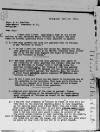
|
November 10, 1931.
Letter from Mr. J. A.
Willey to Capt. D. A. Stafford Proposing
Revived Voluntario Program in the
Jinotega-Matagalpa Coffee Districts, p. 1. "Matagalpa
Nov. 10 1931. ¶ Capt. D. A. Stafford ¶
Department Commander G. N., ¶ Matagalpa. ¶
Dear sir;- ¶ I have your letter inclosing a
copy of the letter written by Gen. Matthews
about “Civicos en finca.” You have asked me
several questions which I will endeavor to
answer. ¶ I. Q.--How many growers who have
not guardias will be willing to pay “Civicos
en finca.” ¶ A.--So far I have not found any
except Mr. Hawkins who has four guarding his
house at La Garita. Possibly Chas. Potter
who is on the way from England now might be
willing to pay for “Civicos en Finca.” ¶
Q.--How many growers who now have guardias
will agree to the reduction of their
guardias and replace them man for man by
“Civicos en finca,” with a view of using the
guardias released. 1st. for forming a (50)
man guardia post in the vicinity of Guasaca
for the prosecution of aggressive warfare
against the bandits. 2nd. for nuclei of
other finca guards composed of guardias and
“Civicos en finca.” ¶ A.--So far I have not
found one who wants to relinquish one of his
guardias on his hacienda. They seem quite
willing to aid in the payment of a force of
sixty men but without interferring
[interfering] with their finca guardias. ¶
Q.--Express your opinion of the plan in
general. Please advise your opinion of the
advisability of establishing small outposts
of “Civicos en finca” in the Department of
Matagalpa. ¶ A.--I believe that outposts of
“Civicos en Finca” if they were not very
much in the majority Guardias, would be very
dangerous, as the bandits would most likely
watch them and attack them when least
prepared in order to get more arms and
ammunition. This plan might work well in
other parts of the country where only a few
men could well guard a place on account of
no big armed groups working in that vecinity
[vicinity], but in the department of
Matagalpa and Jinotega, I think the outposts
as they are today are not any too large, and
that they are just about as small as they
could be and not be in great danger. . . . "
|
|
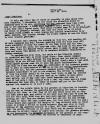
|
November 10, 1931.
Letter from Mr. J. A.
Willey to Capt. D. A. Stafford Proposing
Revived Voluntario Program in the
Jinotega-Matagalpa Coffee Districts, p. 2. "
. . . ¶ If only say about two or three or
possibly in some cases four were replaced, I
personally do not think the situation would
be weakened much if at all, providing the
men replaced were real loyal men to the
hacienda. I think most growers could easily
put out 3 men they could depend upon. That
would release some 35 to 40 men, [what
appears to be “guardias” is handwritten
here] who would be properly trained, and
that the other 20 or 25 could be taken forom
[from?] plazas or other places and civicos
substituted in small numbers, and thereby
release the proper number of men who would
be well trained guardias. ¶ I believe that
leaving the ourpsts [outposts] as they are,
and sending out 60 well seasoned and well
trained guardias with the very best officers
available to keep out north of the Tuma
river ALL the time, not come in at all until
the crop was over, and keep on the move ALL
the time, that the Bandits would either have
to mass in large numbers and crush that
patrol or be in constant movement themselves
to escape contact. ¶ In conjunction with
this, the radio at Los Placeres should be
installed and kept in first class order.
Then runner communication should be kept
between the big patrol and the nearest radio
station. Also the officer with the big
patrol should have a real good intelligence
system even tho [though] it cost him quite
considerable [considerably]. He also must be
a man who can gain the confidence of the
innocent people and be able to descriminite
[discriminate] at once as to who are bandit
sympathizers and who are not, and not
persecute unarmed people who may be of
invaluable assistance to him in his mission.
The officer in command of this big patrol
should be the very best there is in the
service now for that work. For I believe
that he is liable to have quite some action,
and he may find that the60 [the 60] Guardias
are none to many of he gets a real contact
with a real big force such as Pedro
Altamirano has been able at times to muster
and put in the field against his enemies or
to loot a town. ¶ One of the points taken by
the growers in objection to furnishing the
men, to replace the guardias, and assuming
the entire responsibility for them, is that
they do not now, trust their men as they did
some years ago, and really do not know just
what men to pick out for this duty, ALSO
they are very much against the impression
getting out that they are arming their men
and are the men behind the guns of their own
hand picked men, for they doubt that the
small forces would cope against the bandits
if they actually made up their minds to
attack a “Civico en finca” outpost. They are
loud in their praises of the guardias[’]
ability to fight, BUT THEY complain a lot
that the gurdia [guardia] officers do not
keep their men on enough patrol. This may be
without reason or maybe with reason. The
growers probably do not understand the
movements of the gurdias [guardias] or the
reasons, sufficient to understand the
motives or character of same. . . . "
|
|
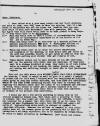
|
November 10, 1931.
Letter from Mr. J. A.
Willey to Capt. D. A. Stafford Proposing
Revived Voluntario Program in the
Jinotega-Matagalpa Coffee Districts, p. 3. "
. . . ¶ I have talked with a good many
people and had their opinions, and most of
them, over 90%, seem to have the opinion,
that if a force of volunteers was put out
after the Bandits that the results would be
much more successful than with guardias,
BUT, they all agree that this force would
have to be hand picked in many ways. ¶ 1. --
They would have to be volunteers. ¶ 2. --
Each man would have to have a letter of
reccomendation [recommendation] from some
one of considerable importance as to his
merits to fit the job in every way. ¶ 3. --
These men would have to be officered by a
Guardia officer of special qualifications.
Also a Nicaraguan officer of special
qualifications. Two men who would work
together. ¶ 4. -- These men would have to be
under the direct supervision and disciplin
[discipline] of the Guardia, or they would
soon get tired of the work and possibly
desert, or get slack as soon as they saw
they were getting paid whether they got
results or not. ¶ 5. -- Tihis [This] patrol
should not be used outside of its own
territory, that is, the country with which
they are familiar. If they were sent to a
strange district or area, they would be of
very little value on account of not knowing
the roads, people etc., and not having had
suffering brought on their own in that
particular region. ¶ With all the talk about
this MYSTERY [what appears to be “native”
handwritten here] FORCE THAT COULD
EXTERMINATE the bandits, I think it would be
well to give it a trial. A patrol of picked
men for this work, I believe, with the
conditions as outlined above given to each
man before enlisted, and then KEPT OUT
CONTINUALLY NORTH OF THE TUMA RIVER
excepting unless they were in contact and
fighting the bandits south into the lines of
the outposts now stationed there, would
sooner or later get a serious contact with
the bandits and force them to show their
force or keep them scattered or outside of
the present crop activities. ¶ I would say
put a few active guardias in among them as
the trained automatic weapon men. That would
give a security to those in command that
they might not feel with only the CIVICOS. I
would not consider for a moment that this
force was to go out under the command of
some Nicaraguan who might turn POLITICO and
commit all sorts of indiscretions which
would be charged up against the American
officers. However the officer in command of
this force shpuld [should] have all the
powers given to one generally who is sent to
accomplish a military objective. Not to be
hampered by formalities. He could be amply
protected by the “Martial Law” which now
exists . . . "
|
|
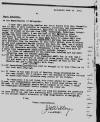
|
November 10, 1931.
Letter from Mr. J. A.
Willey to Capt. D. A. Stafford Proposing
Revived Voluntario Program in the
Jinotega-Matagalpa Coffee Districts, p. 4. "
. . . in the Departamento of
Matagalpa. ¶ I know that something similar
was tried before with Gen. Escamilla and is
said to have resulted in personal,
political, and unnecessary persecutions, and
very expensive. This plan is somewhat
different. He picked up his men from Leon,
Chinandega, Posaltega, Chichigalpa, and
there about. I saw him when he was gathering
those fellows who were his soldiers in the
past revolution of 1926-27. The class of men
to be used in this case would be picked ONLY
from this area. Men vouched for by
responsible parties. Men mostly who have
suffered from the bandits. If this force
failed, also officered by the most competent
Marine officer you have for that, and a
picked Nicaraguan officer with him. If this
force failed, I fear that there is not any
immediate solution. Personally I feel that
this sort of a force will demonstrate
conclusively several things;- ¶ 1.--If a
force of volunteers of the districts
infected are any more effective than the
trained guardias. ¶ 2.--If the Bandits have
any real organized ARMY. For in this case I
think that the officer in charge of this
patrol will smoke them out and sitir [stir?]
up a hornets nest for himself as well as for
the Bandits and get a real battle with them.
¶ 3.--If exceptional [what appears to “and
reliable” handwritten here] information will
be brought in to this force as it has been
said long ago. ¶ 4.--If there is any hope at
all of Banditry being exterminated in the
near future. For I believe that the success
or failure of such an expedition would
determine many points of the future. ¶ In
conclusion I do not think this force should
be less than 60 men, with replacements
available, and I would much rather see it
100 men. If the Matagalpa people would
finance 60 of them, I think the Nicaraguan
Government should finance the other 40. ¶
Hoping this letter is not too long and
answers the questions you have put to me,
and that something will develope [develop]
which will help out the present bandit
situation in the Departamento of Matagalpa,
¶ I am, ¶ Yours respectfully, ¶ J.A.
WILLEY."
|
|
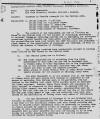
|
November 16, 1931.
"Increase in Guardia
strength for the Central Area," Central Area
Commander Col. Julian C. Smith to Jefe
Director, Managua, p. 1. "3rd
Endorsement ¶ 16 November, 1931 ¶
HEADQUARTERS CENTRAL AREA, GUARDIA NACIONAL,
JINOTEGA, NICARAGUA. ¶ From: The Area
Commander. ¶ To: The Jefe Director, Guardia
Nacional, Managua. ¶ Subject: Increase in
Guardia strength for the Central Area. ¶
Enclosures: 5. Letter from Mr. J.A. Willey.
¶ Letter from Mr. Guillermo Huper. ¶ Letter
from Senor F. Somarriba. ¶ Letter from Senor
Ernesto C. Salazar. ¶ Letter from Chamber of
Commerce, Jinotega. ¶ 1. The subject of the
employment and use of “Civicos en Finca” in
the Central Area for the purpose of
furnishing protection to isolated fincas, or
releasing guardia now so employed, for
offensive operations against bandits has
been given careful consideration and the
proposition has been laid before the Jefe
Politicos and prominent finca owners of the
Departments of Matagalpa and Jinotega, as
well as before the Chamber of Commerce of
Jinotega. ¶ 2. The opinions received were
unanimously opposed to placing armed Civicos
on the Fincas in the Central Area. ¶ 3. The
reasons given are as follows: ¶ (a) The
utter impossibility of selecting from the
rural inhabitants of this Area men who can
de depended upon to remain loyal to their
employers and to the Government. ¶ (b) Due
to the proverty [poverty] stricken condition
very few finca owners are able to bear the
expense involved. ¶ (c) Small groups of
armed Civicos even if loyal would invite
bandit attacks for the purpose of securing
their arms. ¶ 4. The Area Commander is of
the opinion that if the owners of Fincas
which now have guards were willing to
cooperate to the extent of employing five
civicos each, to be guartered [quartered],
fed and trained by the Guardia that about
fifty guardia would be released for other
purposes. However these finca owners are
unanimous in their refusal to cooperate in
this manner. In dealing with the foreign
finca owners, who now have guards,
consideration must be given to the fact that
one is a woman and all but two of the others
are men past sixty years of age, who are
naturally very much concerned at the
possibility of losing their only means of
livelihood. ¶ 5. For the Department of
Jinotega it is not believed that “Civicos en
Finca” are practicable for the reasons given
in paragraph 3 and also for the addition
reason that even though reliable men could
be secured proper leadership would be
necessary to inspire them to resist attacks
by superior forces of bandits. Such
leadership is lacking in this Department as
none of the larger finca owners or managers
live on their property and none are willing
to do so even during the coffee season with
anything less than the protection afforded
by regualr [regular] guardia posts. . . . "
|
|
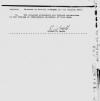
|
November 16, 1931.
"Increase in Guardia
strength for the Central Area," Central Area
Commander Col. Julian C. Smith to Jefe
Director, Managua, p. 2. "
. . . ¶ 6. The attached statements are
typical expressions of the feeling of
influential residents of this Area. ¶ Julian
C. Smith."
|
|
|
|
|
End of Page 3 & document collection on Los
Voluntarios.
|
|
|
|
|
|
|
|
|
|
TOP OF PAGE
|
|
|
|
